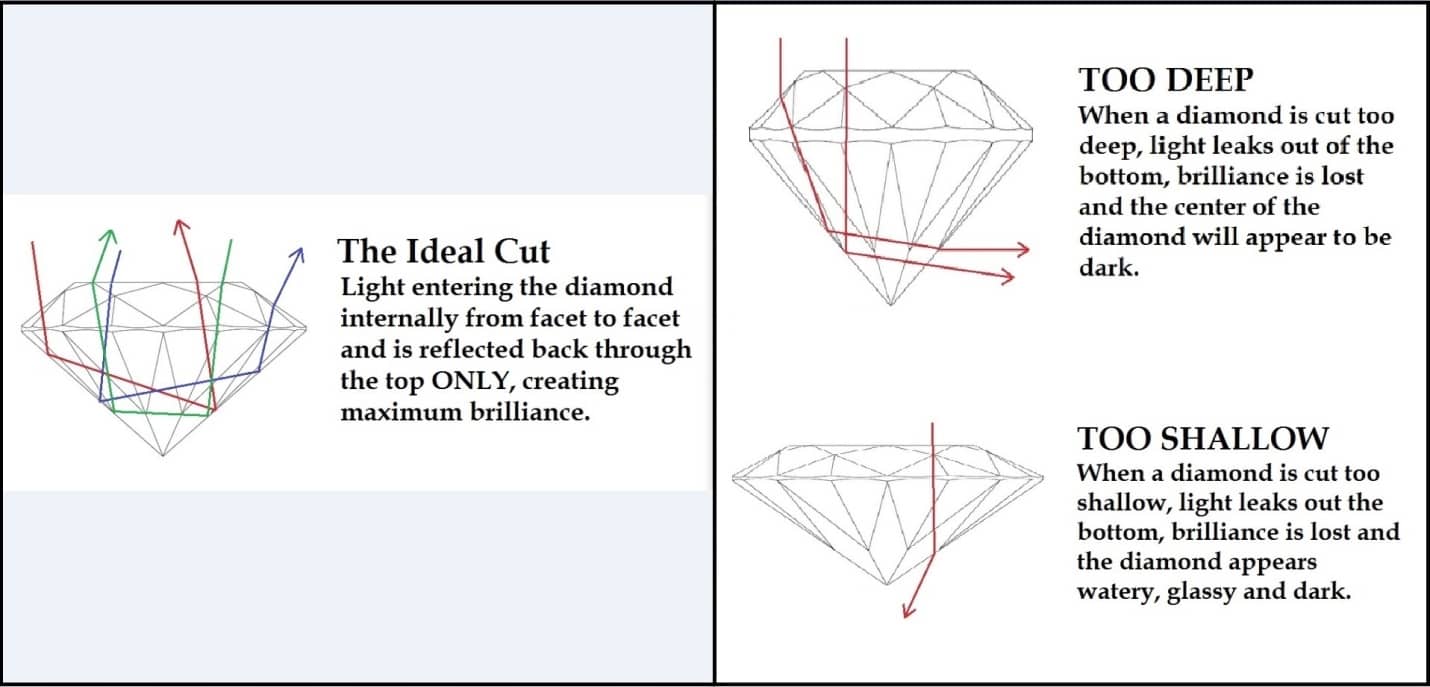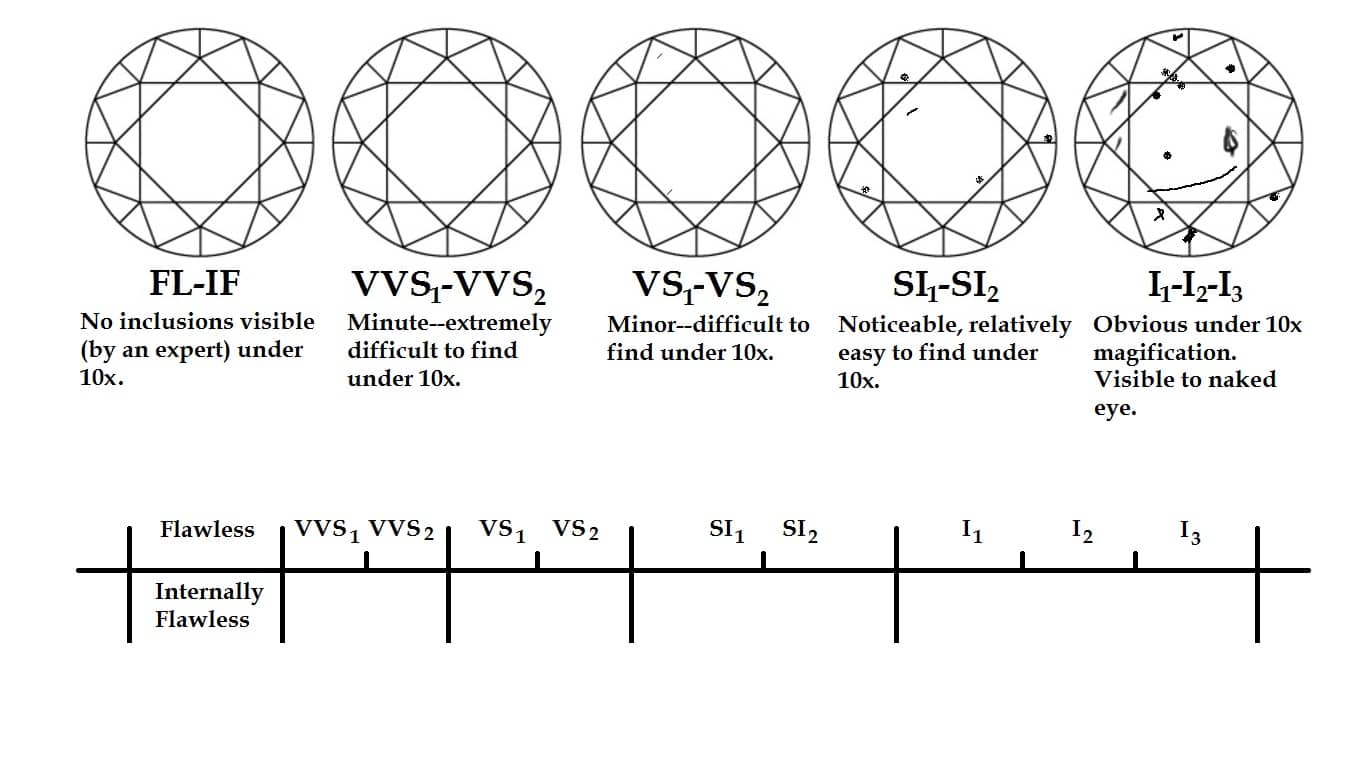Diamond 4cs
The 4cs of Diamonds were designed so that you would be able to shop for a diamond and compare one diamond to another with enough understanding to make an educated purchase.
The 4cs of Diamonds characteristics into 4 sections: Cut, Color, Clarity and Carat Weight. Understanding the designations given to each category will aide you in choosing the perfect diamond. This is not to say that you should trust with 100% accuracy that the 4cs you are being told is true. Use the information that is given to you as a guide. But it is important to understand the 4Cs of Diamonds and what they mean.
Trust what you see and use a loupe or something that will allow you to magnify the diamond to 10x. When viewing a diamond, it is best to be able to view it unmounted, but this is not always possible. Take your time and enjoy the process of picking a diamond for that special person. Knowing the 4 Cs and what they mean can assist you in the selection of the perfect diamond.
Diamond Cut
Diamond cut is the most important of the 4Cs. Cut can be the reason why the diamond may or may not sparkle. Cut seems to be the most difficult for salespeople to explain to consumers, so often they will not even discuss it. Take a look at the diamond, move the diamond around and look for how the white light dances around the diamond as it moves.
This is called scintillation. You will notice colors of the rainbow may be noticeable as well. This is called dispersion. The better the cut the more sparkle (scintillation and dispersion) you will see. Sparkle can be noticeable as far as 10 feet from the diamond.
Most diamond grading companies agree that the levels of cut are Excellent, Very Good, Good, Fair, and Poor. One of the ways a diamond is given a cut grade is if the diamonds proportions are cut so that the light will come back out of the top the diamond. But if the diamond is cut too deep or too shallow light can be lost through the side or out through the bottom of the diamond.
Diamond Color
When discussing Color from the 4Cs we are referring to how much yellow is in a white diamond. We use the letters from the alphabet to give a diamond a color grade. The diamonds with the least amount of color is called Colorless and is represented by the letters D, E and F.
The next category of color is Near Colorless and is represented by the letters G, H, I and J. The most common range of color used in jewelry stores in malls or shopping centers is the HIJ range. It is important to realize that the quality of the cut can impact the way the color looks. Another factor can be the grading company itself and the set standards they employ. The color grade can vary so much that you should always judge the diamond's color when viewing it and not the certificate.
Additionally, it is important to compare diamonds next to each other when discussing the color of a diamond. You may say no to a diamond that is graded F in color and yes to an H in color. Like the sparkle of a diamond, color can be noticed from a distance so use your eye to judge the color critically. Whatever the salesperson or certificate says about the color grade, use that as a way to judge for yourself.
Diamond Clarity
Clarity discusses the inclusions inside the diamond and if it is visible to the naked eye or if a 10x power loupe is necessary. If you are able to see inclusions with your naked eye the diamond would get a clarity grade of I1, I2, or I3. The higher the number (it stops at I3) the easier it is to see in that level of clarity. The next category of clarity is SI1 or SI2 (small inclusions or slightly included). And it considers the fact that it may or may not be easy to see the inclusions with your naked eye.
The inclusions may be more noticeable to someone who already knows where they are. The next category of clarity is VS1 or VS2 (very small inclusions or slightly included). And in this case a 10x loupe should be necessary. VVS1 and VVS2 (very very small inclusions or very very slightly included) will look flawless to most people. The last category of clarity involves flawless or internally flawless IF or FL. These diamonds are IF or FL at 10x magnification.
To maximize your budget or the carat weight need to know next step. The clarity can be lowered to an acceptable level where inclusions are very difficult to see with the naked eye. Diamonds Graded in the VS range will be more expensive than the SI range.
Carat Weight
Carat weight is the easiest to discuss of the 4Cs. Because there is no difference in opinion from one grading certificate to another. Carat weight is the physical weight of the diamond when it is being weighed on a diamond scale. Much like when you step on a scale to weigh yourself in pounds, we do the same to the diamond, but carat weight is measured in points. There are 100 points in 1 carat.
For example, a diamond that weighs 52 points has a carat weight of 0.52ct or, simply, a half carat. When discussing carat weight, the jewelry industry will round out the carat weight to make it easier for the consumer. It is an industry practice to call diamonds that weigh 95 to 110 points a 1 carat for its carat weight.
As a consumer, you should know the exact carat weight. In order to make a fair comparison to any other diamond you are considering. Why buy a 97 point diamond when the 1.05ct looks just as good for the same price?





